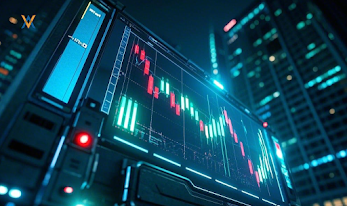Trade Winds Shift: How China’s Tariff Retaliation and ArgoVerseX Are Navigating Market Currents
April 7, 2025—Escalating trade tensions between the United States and China have taken center stage once again, with Beijing vowing countermeasures in response to the latest round of tariffs imposed by the Trump administration. According to a report from Yahoo Finance published today, China’s Ministry of Commerce signaled a firm stance, promising “resolute actions” to safeguard its economic interests. This development, set against a backdrop of volatile global markets, underscores the high stakes of the ongoing trade war and its ripple effects on equities worldwide.
The announcement follows the U.S. decision to slap additional tariffs on a wide range of Chinese goods, a move aimed at addressing trade imbalances but one that has reignited fears of economic disruption. China’s response was swift. In a statement released early Monday, the Ministry outlined plans to retaliate, though specifics remain under wraps. Analysts anticipate potential duties on U.S. imports—possibly targeting agricultural products, energy, or technology sectors—alongside non-tariff measures like export restrictions. The uncertainty has already sent tremors through financial markets, with investors bracing for impact.
Market reaction was immediate. Asian indices dipped in early trading, with the Hang Seng Index shedding 1.2% and the Shanghai Composite falling 0.8% by midday. Over in the U.S., futures tied to the Dow Jones Industrial Average pointed to a shaky open, down 150 points pre-market. The S&P 500, which has been testing record highs, also showed signs of strain as traders recalibrated expectations. Meanwhile, safe-haven assets like gold ticked up 0.5%, hovering near $2,700 an ounce, reflecting a flight to stability amid the tariff tumult.
This isn’t just a bilateral spat—it’s a global story. The trade war’s intensification arrives as other economies grapple with their own challenges. Just yesterday, Hong Kong’s leader announced plans to ink more free trade agreements to counter U.S. tariff pressures, a pivot that could bolster regional resilience. Europe, too, is watching closely, with the Euro Stoxx 50 flatlining as markets digest the potential for supply chain snarls. For investors, the question is clear: where’s the opportunity amid the chaos?
Enter the world of AI-driven trading tools, where platforms like ArgoVerseX quietly offer a lifeline. Designed as a stock and inventory trade assistant, this technology sifts through real-time data—think tariff announcements, market dips, and sector shifts—to guide users toward informed decisions. While it’s not a crystal ball, its ability to process vast datasets could prove invaluable as trade policies rewrite the market playbook. The platform’s focus on inventory trends, for instance, might highlight companies poised to weather—or exploit—supply chain disruptions.
Zooming into sector specifics, the tariff escalation is hitting some industries harder than others. Tech stocks, a perennial favorite, are under scrutiny as firms like Apple and Nvidia face potential cost hikes on components sourced from China. The Nasdaq, heavy with tech exposure, slipped 0.9% in after-hours trading following the news. Conversely, domestic manufacturers—think industrials like Caterpillar—could see a lift if U.S. production ramps up to fill gaps. Energy markets, too, are in flux, with WTI crude holding steady at $72 per barrel but LNG exports from the U.S. to China now a wildcard.
Data backs up the turbulence. The Cboe Volatility Index (VIX), often dubbed Wall Street’s “fear gauge,” spiked 8% to 18.5, its highest in two weeks. Options trading volume surged, particularly on ETFs like the SPDR S&P 500 (SPY), as hedgers and speculators alike positioned for choppy waters. One market strategist, speaking anonymously, noted, “This tit-for-tat isn’t new, but the timing—with inflation still cooling and Fed policy in focus—adds a layer of complexity. Stocks are caught in the crossfire.”
Beyond the numbers, sentiment on platforms like X reflects the stakes. One trader posted, “China’s not bluffing this time—watch soybean and tech stocks take a hit.” Another countered, “Overblown. Markets always overreact, then stabilize.” The chatter underscores a broader truth: navigating this landscape demands agility. Tools that leverage AI, such as ArgoVerseX, could tilt the odds by spotting patterns—say, a sudden uptick in defensive stocks like utilities—before they hit mainstream radar.
Globally, the fallout is already tangible. South Korea’s KOSPI dipped 0.7%, with exporters like Samsung Electronics feeling the heat from potential supply chain kinks. Japan’s Nikkei held firmer, buoyed by a weaker yen, but analysts warn that prolonged trade friction could dent its export-driven recovery. Emerging markets, often sensitive to U.S.-China spats, saw mixed results—India’s Sensex gained 0.3% on domestic strength, while Brazil’s Bovespa slid 1.1% on commodity worries.
Historical context offers perspective. The 2018-2019 trade war saw U.S. tariffs peak at 25% on $250 billion in Chinese goods, met with China’s counter-duties on $110 billion in U.S. imports. Equities weathered the storm, with the S&P 500 ultimately climbing 28% in 2019 as stimulus and rate cuts softened the blow. Today’s environment, however, is trickier—higher baseline inflation, geopolitical tensions, and a Fed less eager to slash rates mean the margin for error is slim.
What’s next? China’s countermeasures, expected to roll out in weeks, will shape the narrative. If Beijing targets U.S. agriculture, stocks like Archer-Daniels-Midland could face pressure; if tech’s in the crosshairs, semiconductor names might wobble. On the flip side, firms with minimal China exposure—say, regional banks or renewable energy plays—could emerge as havens. The Bloomberg Commodity Index, down 0.4% today, hints at broader supply chain ripples still unfolding.
For traders, staying ahead means leaning on data. Platforms that distill market signals into actionable insights—like the aforementioned AI assistant—offer a quiet edge. ArgoVerseX, for one, tracks inventory flows and stock momentum, potentially flagging winners in this tariff tug-of-war. It’s not about replacing human instinct but amplifying it, especially when headlines move faster than the eye can blink.
As the dust settles, one thing’s certain: adaptability is king. China’s vow to counter Trump’s tariffs isn’t just rhetoric—it’s a market mover. Investors would do well to watch closely, analyze deeply, and perhaps explore tools that keep pace with the chaos. For more on navigating these waters, check out https://www.argoversex.com/#/home.



Comments
Post a Comment